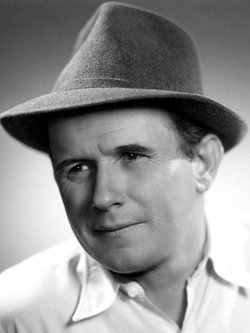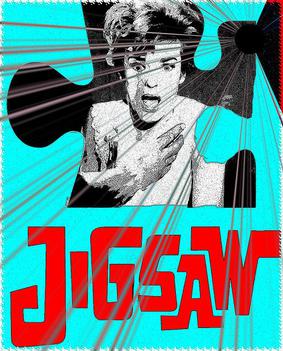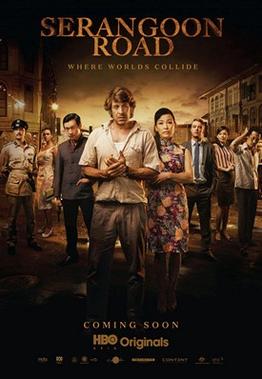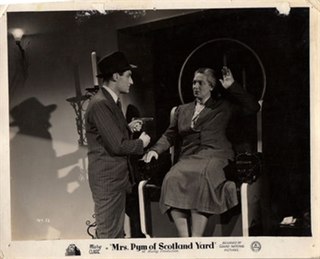The following is an overview of 1930 in film, including significant events, a list of films released and notable births and deaths.

Joan Geraldine Bennett was an American stage, film, and television actress, one of three acting sisters from a show-business family. Beginning her career on the stage, Bennett appeared in more than 70 films from the era of silent films, well into the sound era. She is best remembered for her film noir femme fatale roles in director Fritz Lang's films—including Man Hunt (1941), The Woman in the Window (1944), and Scarlet Street (1945)—and for her television role as matriarch Elizabeth Collins Stoddard in the gothic 1960s soap opera Dark Shadows, for which she received an Emmy nomination in 1968.

William Taylor "Tay" Garnett was an American film director, writer, and producer. He made nearly 50 films in various genres during his 55-year career, The Postman Always Rings Twice and China Seas being two of the most commercially successful. In his later years, he focused mainly on television.

The Limping Man is a 1953 British second feature ('B') film noir directed by Cy Endfield and starring Lloyd Bridges, Moira Lister and Leslie Phillips. The film was made at Merton Park Studios and was written by Ian Stuart Black and Reginald Long based on Anthony Verney's novel Death on the Tideway. Endfield directed it under the pseudonym Charles de Lautour due to his blacklisting in Hollywood. Location shooting took place around London including The Mayflower pub in Rotherhithe.

Eternally Yours is a 1939 American comedy drama film produced and directed by Tay Garnett with Walter Wanger as executive producer, from a screenplay by C. Graham Baker and Gene Towne. The film stars Loretta Young and David Niven, and also features a strong supporting cast including Broderick Crawford, Billie Burke, Eve Arden, ZaSu Pitts, and C. Aubrey Smith. Composer Werner Janssen was nominated for the Academy Award for Best Music.

One Way Passage is a 1932 American pre-Code romantic film starring William Powell and Kay Francis as star-crossed lovers, directed by Tay Garnett and released by Warner Bros. The screenplay by Wilson Mizner and Joseph Jackson is based on a story by Robert Lord, who won the Academy Award for Best Story.

Curtain Up is a 1952 British comedy film directed by Ralph Smart and starring Robert Morley, Margaret Rutherford and Kay Kendall. Written by Jack Davies and Michael Pertwee it was based on the 1949 play On Monday Next by Philip King.

Grand National Night is a 1953 British second feature ('B') thriller film directed by Bob McNaught and starring Nigel Patrick, Moira Lister and Beatrice Campbell. It was produced by George Minter and Phil C. Samuel, and written by Val Valentine and Bob McNaught based on the 1945 play of the same title written by Campbell and Dorothy Christie.

Footsteps in the Dark is a 1941 American comedy mystery film directed by Lloyd Bacon and starring Errol Flynn, Brenda Marshall and Ralph Bellamy. It was produced and distributed by Warner Bros. Flynn plays a novelist and amateur detective investigating a murder. It takes its title from the 1935 play Footsteps in the Dark by Ladislas Fodor and also used material from the 1937 play Blondie White by Jeffrey Dell.

Jigsaw is a 1962 British black and white crime film directed by Val Guest and starring Jack Warner and Ronald Lewis. The screenplay was by Guest based on the 1959 police procedural novel Sleep Long, My Love by Hillary Waugh, with the setting changed from the fictional small town of Stockford, Connecticut, to Brighton, Sussex, while retaining the names and basic natures of its two police protagonists and most of the other characters.

Hour of Decision is a 1957 British mystery film directed by C. M. Pennington-Richards and starring Jeff Morrow, Hazel Court and Anthony Dawson. It was written by Norman Hudis based on the 1954 novel Murder in Mayfair by Frederic Goldsmith.
The High Terrace, also known as High Terrace, is a 1956 black and white British second feature ('B') mystery film directed by Henry Cass and starring Dale Robertson, Lois Maxwell, Derek Bond, Eric Pohlmann and Lionel Jeffries. It was written by Norman Hudis, Alfred Shaughnessy and Brock Williams from an original story by A. T. Weisman.

Saloon Bar is a 1940 British comedy thriller film directed by Walter Forde and starring Gordon Harker, Elizabeth Allan and Mervyn Johns. It was made by Ealing Studios and its style has led to comparisons with the later Ealing Comedies, unlike other wartime Ealing films which are different in tone. It is based on the 1939 play of the same name by Frank Harvey in which Harker had also starred. An amateur detective tries to clear an innocent man of a crime before the date of his execution.

The Voice of Merrill is a 1952 British mystery film directed by John Gilling and starring Valerie Hobson, James Robertson Justice and Edward Underdown. It was written by Gilling, Gerald Landeau and Terence Austin. The film was made by Tempean Films, the company owned by the film's producers Monty Berman and Robert S. Baker, which between the late 1940s and the late 1950s specialised in turning out low-budget B-movies as unpublicised second-features for the UK cinema market. On its release however, The Voice of Merrill was recognised by its distributors, Eros Films, as unusually sophisticated and stylish for a B-movie, and was elevated to the status of co-feature in cinemas. It was released in the USA the following year under the title Murder Will Out.

Mystery House is a 1938 American mystery crime film directed by Noel M. Smith and starring Dick Purcell and Ann Sheridan as nurse Sarah Keate, and is based on the 1930 novel The Mystery of Hunting's End by Mignon G. Eberhart. Sheridan also played the same character in The Patient in Room 18, released in January 1938, while Aline MacMahon played her in While the Patient Slept in 1935.

Serangoon Road is an Australian-Singaporean drama television series that premiered on 22 September 2013 on ABC and HBO Asia. It is a detective noir drama set in Singapore in the mid-1960s.

The Murder of Dr. Harrigan is a 1936 American mystery film directed by Frank McDonald and written by Peter Milne and Sy Bartlett. The film stars Ricardo Cortez, Kay Linaker, John Eldredge, Mary Astor, Joseph Crehan and Frank Reicher. The film was released by Warner Bros. on January 11, 1936. A story by Mignon G. Eberhart was the basis for the film.

The Lady in the Morgue is a 1938 American mystery film directed by Otis Garrett and written by Eric Taylor and Robertson White. It is based on the 1936 novel The Lady in the Morgue by Jonathan Latimer. The film stars Preston Foster, Patricia Ellis, Frank Jenks, Thomas E. Jackson, Wild Bill Elliott, Roland Drew and Barbara Pepper. The film was released on April 22, 1938, by Universal Pictures.

The Malpas Mystery is a 1960 British second feature ('B') crime film, directed by Sidney Hayers and starring Maureen Swanson and Allan Cuthbertson. The screenplay was by Paul Tabori and Gordon Wellesley, based on the 1924 Edgar Wallace novel The Face in the Night.

Mrs. Pym of Scotland Yard is a 1939 British comedy-drama film directed by Fred Elles starring Mary Clare in her only title role and Nigel Patrick in his film debut. It is based on the Mrs Pym novels by Nigel Morland, and written by Morland, who re-used the title for a 1946 book.


















